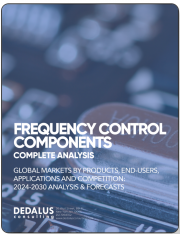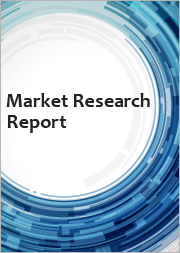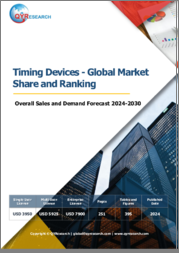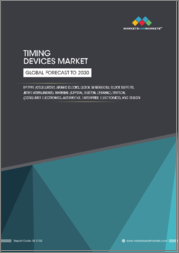
|
시장보고서
상품코드
1694038
유럽, 중동, 아프리카의 주파수 제어 및 타이밍 장치 시장 : 점유율 분석, 산업 동향, 성장 예측(2025-2030년)EMEA Frequency Control And Timing Devices - Market Share Analysis, Industry Trends & Statistics, Growth Forecasts (2025 - 2030) |
||||||
유럽, 중동, 아프리카의 주파수 제어 및 타이밍 장치 시장 규모는 2025년에 20억 9,000만 달러, 2030년에는 28억 1,000만 달러에 이를 것으로 예측됩니다. 예측 기간(2025-2030년)의 CAGR은 6.1%를 나타낼 전망입니다.

주파수 제어 및 타이밍 장치 시장은 러시아와 우크라이나 분쟁과 경기감속에 의해 큰 혼란에 직면했습니다.
주요 하이라이트
- 스마트 홈 기술의 채용 확대가 시장 성장에 밝은 전망을 가져옵니다.
- GSMA의 보고서에 따르면 MENA 지역의 스마트폰 보급률은 2018년 54%에서 2025년 74%로 증가할 것으로 예측됩니다. 스마트폰이 전체 접속의 61%를 차지하게 됩니다.
- 로봇은 동기화 동작과 시간에 민감한 작업을 위해 발진기를 사용합니다.
- 첨단 자동차 용도의 대두는 자동차 산업에 있어서의 유럽, 중동, 아프리카의 주파수 제어 및 타이밍 장치의 성장의 큰 원동력이 되고 있습니다. 자동 긴급 브레이크, 차선 이탈 경고, 적응형 크루즈 컨트롤을 위한 실시간 센서 데이터 처리에 의존합니다.
- 주파수 제어 및 타이밍 장치 시장은 일렉트로닉스 산업 중에서도 중요한 부문이며, 다양한 용도에 필수적인 컴포넌트를 제공합니다.
- GDP 성장, 정부 예산 제약, 지정 학적 요인, 재정 시책 등의 요인은 유럽, 중동, 아프리카의 군사 지출에 큰 영향을 미칩니다. 00만 달러로 추정되며, 2014년 이후 최고의 지출입니다.
유럽, 중동, 아프리카의 주파수 제어 및 타이밍 장치 시장 동향
자동차산업이 최종사용자로 급성장
- 자동차 산업에서는 주파수 제어 및 타이밍 장치는 적응 크루즈 컨트롤, 차선 지원, 충돌 회피를 위한 ADAS, 부드러운 음악 재생과 정확한 GPS 기능을 위한 인포테인먼트 시스템, 실시간 추적과 커넥티드 차량을 위한 텔레매틱스 등에 사용되고 있습니다.
- 자동차 부문은 유럽, 중동, 아프리카의 주파수 제어 및 타이밍 장치 시장에서 사업을 전개하는 벤더에게 유망한 시장입니다.
- 자율주행, 전동화, 연결성, 쉐어드 차량이 자동차 부문 시장 성장을 가속하는 동향입니다. 그 기술에 의존하는 고성능 전자 시스템이 몇 개 탑재되고 있습니다.
- 유럽, 중동, 아프리카 시장 성장은 소비자의 기호의 변화, 기술의 진보, 전기자동차의 인기가 높아진 것으로 예측됩니다.
- 예를 들어 유럽연합(EU)의 자동차 시장은 2023년에 전년대비 13.9%의 대폭적인 성장을 이루었으며, 연중 총 판매대수는 1,050만대가 되었습니다.
- 배터리 전기자동차는 2023년에 구매자들 사이에서 3번째로 인기 있는 선택으로 떠올랐습니다. 3.6%에 머물렀던 디젤차의 안정된 시장 점유율을 웃돌았습니다.
독일이 주요 시장 점유율을 차지
- 독일은 자동화, 데이터 교환, IoT 기술이 제조업에 융합하는 인더스트리 4.0을 선도하고 있습니다. 이러한 '스마트 공장'에서는 정확한 타이밍이 중요합니다.
- 독일의 소비자용 전자기기·웨어러블 장치 시장은 혁신적인 가젯이나 커넥티드 장치에 대한 소비자 수요가 견인하고 있습니다. 스마트폰, 웨어러블 장치, 소비자용 전자 기기 제품에는 클럭 동기화, 데이터 처리, 연결용 타이밍 장치가 내장되어 있는 경우가 많습니다. 소비자의 선호도가 지능적이고 연결된 장치로 이동함에 따라 최신 소비자 전자 제품의 요구 사항을 충족할 수 있는 컴팩트하고 저전력 타이밍 솔루션에 대한 수요가 지속적으로 증가하고 있습니다.
- GSMA Intelligence가 제공하는 데이터에 따르면 독일은 2025년까지 연결 수로 유럽의 주요 스마트폰 시장으로 떠오르고 있으며, 시장 규모는 1억 500만 달러에 달할 것으로 예측되고 있습니다. 독일 스마트폰 보급률은 2021년 80%에서 2025년 84%로 상승할 것으로 예측됩니다.
- 독일에서는 방위 및 항공우주 부문에서 고성능 타이밍 솔루션에 대한 수요가 높아지고 있습니다. 이러한 솔루션은 레이더 시스템, 통신 네트워크 및 위성 페이로드에 적용됩니다. 새로운 위협과 싸우는 방어 요구가 진화함에 따라 수요는 첨단 타이밍 장치로 이동하고 있습니다. 이러한 장치는 견고한 성능을 제공하고 향상된 신뢰성과 보안 기능을 자랑해야 합니다. 타이밍 솔루션을 전문으로 하는 공급업체는 이러한 미션 크리티컬 용도의 까다로운 요구 사항을 충족하도록 제품을 조정함으로써 이익을 얻을 수 있습니다.
- 위의 요약에 따르면 방위산업 발전을 위한 정부의 과잉투자는 연구시장에 새로운 성장 기회를 창출하게 됩니다. SIPRI에 따르면 2023년 정부는 방어 예산에 약 3.08%를 투자했습니다.
- 이 나라는 혁신과 기술 개발을 추진하기 위해 산학 연구기관의 제휴를 촉진하고 있습니다. 협력 연구 이니셔티브와 파트너십은 타이밍 디바이스 공급업체가 최첨단 연구 프로젝트에 참여하고, 신기술을 개발하며, 혁신적인 솔루션을 상용화할 수 있는 기회를 제공합니다. 공동 네트워크를 통해 이용 가능한 전문 지식과 자원을 활용함으로써 기업은 경쟁을 획득하고 선진적인 타이밍 솔루션의 개발과 채택을 가속할 수 있습니다.
유럽, 중동, 아프리카의 주파수 제어 및 타이밍 장비 산업 개요
유럽, 중동, 아프리카의 주파수 제어 및 타이밍 장비 시장은 Murata Manufacturing, Kyocera, Rakon Limited, Microchip Technology Inc., TXC Corporation 등의 주요 기업이 존재하고 세분화되어 있습니다.
2024년 4월 첨단 전자부품 제조업체인 KYOCERA AVX는 KYOCERA AVX Components Corporation(Erie)의 명칭으로 고품질, 저소음의 수정 진동자 주파수 제어 제품의 새로운 제조 및 설계 센터를 발표했습니다.
2024년 2월 Error Exchange OCXO(MercuryXE2)는 라콘이 최근 출시한 Mercury 소형 IC-OCXO의 버전입니다.
기타 혜택
- 엑셀 형식 시장 예측(ME) 시트
- 3개월의 애널리스트 서포트
목차
제1장 서론
- 조사의 전제조건과 시장 정의
- 조사 범위
제2장 조사 방법
제3장 주요 요약
제4장 시장 인사이트
- 시장 개요
- 산업 밸류체인 분석
- 산업의 매력 - Porter's Five Forces 분석
- 공급기업의 협상력
- 구매자의 협상력
- 신규 참가업체의 위협
- 대체품의 위협
- 경쟁 기업간 경쟁 관계의 강도
- COVID-19의 영향과 거시 경제 동향의 산업에 대한 영향
제5장 시장 역학
- 시장 성장 촉진요인
- 신흥 용도 증가(IoT 장치, 로봇 등)
- 선진 자동차 용도에서의 수요 증가
- 시장 성장 억제요인
- 높은 개발 비용
제6장 시장 세분화
- 유형별
- 수정 진동자
- 발진기
- 온도 보상형 수정 발진기(TCXO)
- 전압 제어 크리스탈 발진기(VCXO)
- 오븐 제어 수정 발진기(OCXO)
- MEMS 발진기
- 기타 발진기
- 공진기
- 톱 필터
- 실시간 시계
- 최종 사용자 산업별
- 자동차
- 컴퓨터와 주변기기
- 통신/서버/데이터 스토리지
- 소비자 일렉트로닉스
- 산업
- 방위 및 항공우주
- IoT
- 기타
- 국가별
- 영국
- 독일
- 프랑스
- 이탈리아
- GCC 국가
- 남아프리카
제7장 경쟁 구도
- 기업 프로파일
- Murata Manufacturing Co. Ltd
- Kyocera Corporation
- Rakon Limited
- Microchip Technology Inc.
- TXC Corporation
- Seiko Epson Corporation
- Daishinku Corporation
- Hosonic Technology(group) Co. Ltd
- Nihon Dempa Kogyo Co. Ltd
- Sitime Corporation
- Stmicroelectronics NV
- Texas Instruments Incorporated
- NXP Semiconductors NV
- Abracon Llc
- Jauch Quartz
- IQD Frequency Products Ltd
- Euroquartz Ltd
- Geyer Electronic GmbH
- ACT
제8장 투자 분석
제9장 시장 기회와 앞으로의 동향
SHW 25.05.15The EMEA Frequency Control And Timing Devices Market size is estimated at USD 2.09 billion in 2025, and is expected to reach USD 2.81 billion by 2030, at a CAGR of 6.1% during the forecast period (2025-2030).
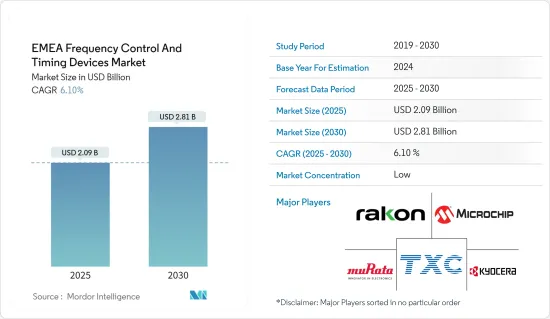
The frequency control and timing device market faced significant disruptions due to the Russo-Ukraine conflict and an economic slowdown. Rising inflation and interest rates curtailed consumer spending, dampened semiconductor demand, and slowed the growth of FCTDs. In response to the conflict, Europe has shifted its focus toward the defense and aerospace sectors, leading to heightened demand for these components and opening up new growth avenues.
Key Highlights
- The rising adoption of smart home technologies creates a positive outlook for market growth. Smart homes consist of interconnected devices such as smart thermostats, lighting systems, security cameras, and appliances that need to communicate and operate seamlessly together. Frequency control and timing devices ensure the synchronization of these devices, providing accurate timing signals for data transmission, control signals, and event scheduling.
- According to the GSMA report, smartphone adoption in the MENA region is expected to increase from 54% in 2018 to 74% in 2025. By 2025, smartphones will make up 61% of all connections in Sub-Saharan Africa. Noticeably, the number of 5G connections is expected to reach 45 million and 41 million by 2025 in the MENA and Sub-Saharan African regions, respectively.
- Robots use oscillators for synchronized operation and time-sensitive tasks. The utilization of industrial robots in the region has been on the rise in numerous end-users and applications due to their ability to improve precision and adaptability, minimize product damage, enhance speed, and ultimately optimize operational efficiency.
- The rise of advanced automotive applications is a significant driver for the growth of EMEA frequency control and timing devices in the automotive industry. The increasing adoption of ADAS is a substantial contributor to the market growth. These systems rely on real-time sensor data processing for automatic emergency braking, lane departure warning, and adaptive cruise control. Frequency control devices provide the accurate timing for these systems to respond promptly and accurately.
- The frequency control and timing devices market is a critical segment within the electronics industry, providing essential components for various applications. However, the high costs of developing and producing these devices challenge the market's growth.
- Factors like GDP growth, government budget constraints, geopolitical factors, and fiscal policies significantly impact military spending in EMEA. According to NATO, in 2023, Spain's defense expenditure was estimated at USD 19.18 billion, the highest spending since 2014. The expenditure was estimated to be USD 14.90 billion in the previous year. Such figures gave Spain the eighth-highest defense expenditure among NATO members.
EMEA Frequency Control And Timing Devices Market Trends
Automotive Industry to be the Fastest Growing End User
- In the automotive industry, frequency control and timing devices are used in ADAS for adaptive cruise control, lane assistance, and collision avoidance, infotainment systems for smooth music playback and accurate GPS functionality, telematics for real-time tracking and connected vehicles, and others. They are also used in electric vehicles to coordinate the operations of electric motors.
- The automotive segment presents promising opportunities for vendors operating in the EMEA frequency control and timing devices market, as the importance of these devices has been increasing in modern automobiles.
- Autonomous driving, electrification, connectivity, and shared vehicles are the trends driving market growth in the automotive sector. Automobiles today contain several high-performance electronic systems that rely on precision timing technology for stable, accurate frequency control of digital components, ranging from application processors to microcontrollers to FPGAs. According to SiTime, a leading frequency control and timing device provider, a typical automobile uses up to 70 timing devices to keep the electrical and electronic systems operating smoothly.
- The market growth in the EMEA region may be attributed to changing consumer preferences, technological advancements, and the increasing popularity of electric vehicles. With the automotive sector shifting toward electric and connected vehicles, there will be a growing demand for oscillators. This will require manufacturers and suppliers to invest in innovative technologies to ensure vehicle safety, performance, and competitiveness.
- For instance, the car market in the European Union experienced a significant growth of 13.9% in 2023 compared to the previous year, resulting in a total sales volume of 10.5 million units for the entire year. This data was reported by the European Automobile Manufacturers' Association (ACEA).
- Battery-electric cars emerged as the third most popular choice among buyers in 2023. In December alone, their market share skyrocketed to 18.5%, contributing to an overall share of 14.6% for the entire year. This surpassed the steady market share of diesel cars, which remained at 13.6%. Petrol cars maintained their dominance with a market share of 35.3%, while hybrid-electric cars secured the second position with a commanding market share of 25.8%.
Germany to Hold Major Market Share
- Germany leads the way in Industry 4.0, where automation, data exchange, and IoT technologies converge in manufacturing. In these 'smart factories,' precise timing is crucial. It synchronizes machines, robotics, and sensors, optimizing production and resource efficiency. As Industry 4.0 takes hold, the need for advanced timing devices in industrial automation and smart manufacturing surges.
- Germany's consumer electronics and wearable devices market is driven by consumer demand for innovative gadgets and connected devices. Smartphones, wearables, and consumer electronics often incorporate timing devices for clock synchronization, data processing, and connectivity. As consumer preferences shift towards intelligent and connected devices, there's a continuous demand for compact, low-power timing solutions that may meet the requirements of modern consumer electronics products.
- According to data provided by GSMA Intelligence, Germany is projected to emerge as the leading smartphone market in Europe in terms of the number of connections, with a value of USD 105 million, by 2025. Germany's smartphone adoption rate is expected to rise from 80% in 2021 to 84% in 2025.
- In Germany, the defense and aerospace sectors increasingly demand high-performance timing solutions. These solutions find applications in radar systems, communication networks, and satellite payloads. With evolving defense needs to combat emerging threats, the demand is shifting toward advanced timing devices. These devices must deliver robust performance and boast enhanced reliability and security features. Suppliers specializing in timing solutions stand to benefit by tailoring their offerings to meet the stringent demands of these mission-critical applications.
- Adhering to the above synopsis, the government's excess investments towards advancing its defense industry will create new growth opportunities for the studied market. According to SIPRI, in 2023, the government invested around 3.08% in its defense budget.
- The country fosters collaborations between industry, academia, and research institutions to drive innovation and technology development. Collaborative research initiatives and partnerships create opportunities for suppliers of timing devices to participate in cutting-edge research projects, develop new technologies, and commercialize innovative solutions. By leveraging the expertise and resources available through collaborative networks, companies can gain a competitive edge and accelerate developing and adopting advanced timing solutions. Such trends and initiatives are expected to drive the market growth in the projected period.
EMEA Frequency Control And Timing Devices Industry Overview
The EMEA Frequency Control And Timing Devices Market is fragmented with the presence of key players like Murata Manufacturing Co. Ltd, Kyocera Corporation, Rakon Limited, Microchip Technology Inc., and TXC Corporation. Key players in the market are adopting strategies such as acquisitions and partnerships to enhance their product offerings and gain sustainable competitive advantage.
In April 2024, KYOCERA AVX, a manufacturer of advanced electronic components, unveiled a new manufacturing and design center for high-quality, low-noise quartz crystal frequency control products under the name KYOCERA AVX Components Corporation (Erie). The newly established production facility could manufacture over 1.2 million patented and unparalleled low-power OCXO (oven-controlled crystal oscillators). It would produce a range of TCXO (temperature-computed crystal oscillators) and VCXO (voltage-computed crystal oscillators).
In February 2024, the Error Exchange OCXO (MercuryXE2) is a version of Rakon's recently launched Mercury compact IC-OCXO. It improves the system's current synchronization abilities on a network synchronizer evaluation board by incorporating frequency error exchange processing and aging compensation, thereby increasing the holdover performance.
Additional Benefits:
- The market estimate (ME) sheet in Excel format
- 3 months of analyst support
TABLE OF CONTENTS
1 INTRODUCTION
- 1.1 Study Assumptions and Market Definition
- 1.2 Scope of the Study
2 RESEARCH METHODOLOGY
3 EXECUTIVE SUMMARY
4 MARKET INSIGHTS
- 4.1 Market Overview
- 4.2 Industry Value Chain Analysis
- 4.3 Industry Attractiveness - Porter's Five Forces Analysis
- 4.3.1 Bargaining Power of Suppliers
- 4.3.2 Bargaining Power of Buyers
- 4.3.3 Threat of New Entrants
- 4.3.4 Threat of Substitutes
- 4.3.5 Intensity of Competitive Rivalry
- 4.4 Impact of COVID-19 Aftereffects and Macro Economic Trends on the Industry
5 MARKET DYNAMICS
- 5.1 Market Drivers
- 5.1.1 Increasing Number of Emerging Applications (such as IoT Devices, Robotics, etc.)
- 5.1.2 Rising Demand from Advanced Automotive Applications
- 5.2 Market Restraint
- 5.2.1 High Cost of Development
6 MARKET SEGMENTATION
- 6.1 By Type
- 6.1.1 Crystals
- 6.1.2 Oscillators
- 6.1.2.1 Temperature Compensated Crystal Oscillator (TCXO)
- 6.1.2.2 Voltage-controlled Crystal Oscillator (VCXO)
- 6.1.2.3 Oven-controlled Crystal Oscillator (OCXO)
- 6.1.2.4 MEMS Oscillator
- 6.1.2.5 Other Types of Oscillators
- 6.1.3 Resonators
- 6.1.4 Saw Filters
- 6.1.5 Real Time Clocks
- 6.2 By End-user Industry
- 6.2.1 Automotive
- 6.2.2 Computer and Peripherals
- 6.2.3 Communications/Server/Data Storage
- 6.2.4 Consumer Electronics
- 6.2.5 Industrial
- 6.2.6 Defense and Aerospace
- 6.2.7 IoT
- 6.2.8 Other End-user Industries
- 6.3 By Country
- 6.3.1 United Kingdom
- 6.3.2 Germany
- 6.3.3 France
- 6.3.4 Italy
- 6.3.5 GCC
- 6.3.6 South Africa
7 COMPETITIVE LANDSCAPE
- 7.1 Company Profiles
- 7.1.1 Murata Manufacturing Co. Ltd
- 7.1.2 Kyocera Corporation
- 7.1.3 Rakon Limited
- 7.1.4 Microchip Technology Inc.
- 7.1.5 TXC Corporation
- 7.1.6 Seiko Epson Corporation
- 7.1.7 Daishinku Corporation
- 7.1.8 Hosonic Technology (group) Co. Ltd
- 7.1.9 Nihon Dempa Kogyo Co. Ltd
- 7.1.10 Sitime Corporation
- 7.1.11 Stmicroelectronics NV
- 7.1.12 Texas Instruments Incorporated
- 7.1.13 NXP Semiconductors NV
- 7.1.14 Abracon Llc
- 7.1.15 Jauch Quartz
- 7.1.16 IQD Frequency Products Ltd
- 7.1.17 Euroquartz Ltd
- 7.1.18 Geyer Electronic GmbH
- 7.1.19 ACT






